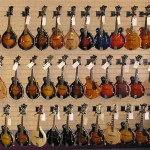A few months back on one of the guitar forums I frequent, a guitarist asked for advice, wanting to buy a cheap mandolin for a country/rock band. Here is my reply, which I’ve expanded on for this blog.
Firstly, always try to buy from a store that deals with a lot of mandolins. Many regular guitar stores won’t even know how to tune a mandolin, never mind set one up. The eyes and ears of people who really know their instruments is invaluable

The bottom line here, as with any instrument, is to buy the best you can afford. You’ll be better off spending a little extra and going for a higher spec instrument rather than making do with something cheaper. You might get lucky and find something cheap that sounds nice and seems to play well but without a proper setup a poorly set nut or bridge or bad fretwork will be harder to recognise.
For amplification, whether you choose an instrument with a piezo or magnetic pickup, do not expect your instrument to ever sound like it does unplugged. Piezo will get you close but cannot capture the open woody-ness of an acoustic instrument. Electric pickups sound like, well, a bit like electric guitars actually! Obviously the tuning and chord voicings are a large part of the sound of the mandolin, and that won’t be lost, but you’ll never sound like Bill Monroe or Chris Thile.
I prefer piezo to electric type pickups but a cheap piezo can sound shrill and aggressive on any instrument, and even more so on a mandolin. To get around that I recommend some sort of EQ pedal, preferably something dedicated to acoustic instruments. I use a Behringer ADI-21 DI. It might be a cheap little box but it works well, and allows me to dial in a sound that won’t make people’s ears bleed. I get a good sound in to the PA or even into the guitar amp. The sound of a guitar amp is not ideal for piezo-equipped instruments but with careful EQ-ing it can work with added convenience of using tuners and effects we use for the guitar.
By the way, high stage volume and mandolins don’t often go well together! If it starts feeding back, it’ll vibrate so hard you’ll think it’ll jump right out of your hands, or shake itself to pieces!
Mandolin strings are hard on the fingers. Tension is high and strings are in pairs, which means that learning the instrument hurts! Do try lighter strings to start off, it’ll save a lot of painful finger tips and joints. Personally, I like D’Addario J73’s, Phosphor bronze, 10-38. You might like the same picks you use for guitar but do try others too. And when you figure out what you like, buy a LOT of them. Mandolin strings rip picks to shreds (at least in comparison to electric guitars).
With eight strings, you will learn the art of patience when tuning. The carved wooden top moves in response to string tension so tuning can be a drag, especially with new strings. A good tuner certainly helps! If you have a pickup of some sort, a standard guitar tuner may work well but not all of them are designed with acoustic instruments in mind. I’ve have good results with the TC Electronic PolyTune and the old Boss TU-2 though it can take a while to get your tuning technique down. And remember the old joke about mandolins – we spend half the night tuning ’em up, and half the night trying to keep ’em in tune.
Beautiful and FUN instruments – good luck!


[…] Choosing a Mandolin (drkevguitar.wordpress.com) Share this:TwitterFacebookLike this:LikeBe the first to like this post. This entry was posted in Folk and tagged Mandolin by Beth. Bookmark the permalink. […]